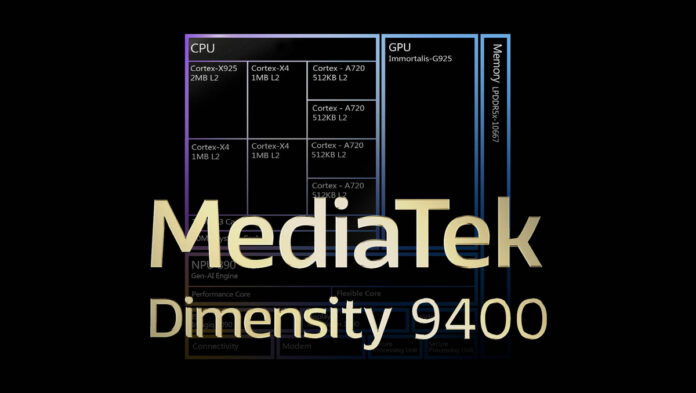
The competition in the flagship smartphone market is increasingly driven by the balance between performance and energy efficiency, with advancements in AI technology playing a crucial role. This trend is evident in the latest mobile chip innovations, where the focus has shifted from raw performance to delivering high computing power with optimized energy use. The introduction of edge AI and the growing complexity of mobile applications are placing new demands on smartphone chips, testing their ability to provide efficient performance without draining battery life.
MediaTek’s newly launched Dimensity 9400 chip, unveiled on October 9, represents a significant leap forward in addressing these challenges. Building on the success of last year’s Dimensity 9300, the 9400 features an all-big-core architecture and introduces substantial improvements in both performance and energy efficiency.
The chip’s CPU performance has improved by 35% in single-core tasks and 28% in multi-core operations. One of the most notable aspects of the Dimensity 9400 is its focus on AI advancements, particularly through enhancements in its NPU (Neural Processing Unit). This has enabled the chip to become the industry’s first smart-body AI chip, making it well-suited for edge AI applications that require low-latency, real-time processing capabilities. MediaTek’s efforts to enhance the NPU’s software and hardware ecosystem have further strengthened the Dimensity 9400’s role in advancing mobile AI technology.
This generational upgrade in chip design reflects broader shifts in the mobile industry, where energy efficiency and AI integration are becoming as important as traditional performance metrics. MediaTek’s strategy with the Dimensity 9400 positions the company as a strong competitor in the high-end smartphone chip market, offering a solution that caters to the increasing demand for smarter, more efficient mobile devices.
The power efficiency of MediaTek’s Dimensity 9400 chip is indeed remarkable, showcasing advancements that push the limits of what’s achievable in mobile chip design. By reducing CPU power consumption by 40% and cutting everyday power usage by up to 32%, the chip demonstrates a balance between high performance and low energy usage that is often viewed as an elusive goal in the semiconductor industry.
At the architecture level, the Dimensity 9400 features a powerful Cortex-X925 supercore clocked at up to 3.62GHz, combined with Arm v9’s PC-grade architecture. Doubling its CPU cache and integrating Samsung’s 10.7Gbps LPDDR5X memory—the fastest available—further boosts the chip’s performance potential. Unlike some competitors, such as Apple and Qualcomm, who rely on pushing clock frequencies beyond 4GHz, MediaTek focuses on improving IPC, allowing the Dimensity 9400 to achieve significant performance boosts without demanding excessive energy.
The use of TSMC’s second-generation 3nm process, with 29.1 billion transistors packed into a compact chip, gives MediaTek an edge in design, particularly in optimizing energy efficiency. This process innovation contributes to the chip’s ability to maintain strong performance while consuming less power, distinguishing it in the competitive landscape.
MediaTek’s Blackhawk architecture, built on Arm v9 and tailored to user needs, enables a 15% improvement in IPC over the Cortex-X4, further underscoring the chip’s cutting-edge capabilities. However, it’s not just the hardware driving these improvements—software plays a vital role. The Dimensity 9400’s advanced scheduling engine intelligently manages performance and power distribution, ensuring that resources are allocated efficiently based on the user’s tasks. This means smoother gaming experiences, faster app launches, and overall system fluidity, even under heavy CPU loads.
MediaTek’s goal to compete directly with Apple is evident in its focus on software enhancements. The Dimensity 9400’s dynamic performance management optimizes resource allocation to provide a seamless user experience, aiming to bring Android’s responsiveness closer to that of Apple devices. For instance, tasks like app launches are now almost instantaneous, typically occurring within 12 milliseconds, a level of consistency that elevates Android’s performance to rival IOS.
By harmonizing its advancements in architecture, process technology, and intelligent scheduling, MediaTek is positioning the Dimensity 9400 as a strong contender in the high-end smartphone chip market, challenging the dominance of established players like Apple and Qualcomm.
Beyond the CPU improvements, the Dimensity 9400 makes groundbreaking strides in mobile gaming. Mobile gaming has shifted into a post-full-frame era where nearly all games can run at full frame rates, eliminating frame-rate competition. Now, the focus has turned to richer visual effects, such as ray tracing, which demands immense processing power without draining energy. MediaTek’s 3A-class ray tracing OMM (Object Motion Management) engine allows for realistic lighting, reflections, and shadow details while minimizing the rendering workload, enhancing the gaming experience without compromising efficiency.
The 12-core Immortalis-G925 GPU in the Dimensity 9400 also delivers a 41% increase in peak performance while using 44% less power, an impressive achievement for mobile devices. In benchmarks such as GFXBench’s 1440p Aztec Ruins Vulkan, performance saw a 38% improvement, while ray tracing performance jumped by 40%. This level of performance allows for advanced visual effects without overwhelming the device’s power capacity, giving gamers both visual and power efficiency improvements.
In addition to gaming advancements, the Dimensity 9400 marks a shift toward greater AI integration at the device level. MediaTek’s Agentic AI Engine enables mobile phones to take on more autonomous roles, capable of reasoning and decision-making based on user behavior. This Agentic AI marks a new era of personalized mobile experiences, as AI evolves from handling simple tasks to more complex scenarios that enhance user engagement and experience.
Source: MediaTek, lesnumeriques, Medium



